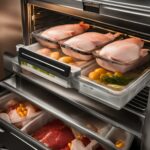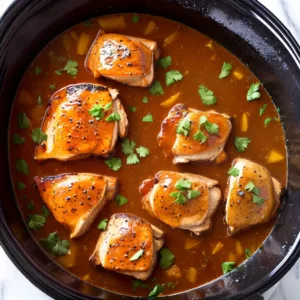As an expert chef, I understand the importance of food safety when it comes to cooked chicken. One question that often arises is: how long can cooked chicken sit out before it becomes unsafe to consume? In this article, I will provide you with essential tips to ensure the safe consumption of cooked chicken.
Key Takeaways:
- Cooked chicken should not sit out at room temperature for more than two hours.
- If the room temperature is above 90°F (32.2°C), the time limit decreases to one hour.
- Bacteria, such as Salmonella and E. coli, can multiply quickly between 40°F and 140°F (4°C and 60°C), known as the Danger Zone.
- Proper storage of cooked chicken is crucial to maintain its safety and quality.
- Follow the two-hour rule to prevent bacterial growth and ensure the safety of the cooked chicken for consumption.
Why You Shouldn’t Leave Cooked Chicken Out
As an expert chef, I cannot stress enough the importance of proper food handling and safety. Leaving cooked chicken out at room temperature is a recipe for disaster. Let me explain why.
When cooked chicken sits out at room temperature, bacteria have the perfect environment to multiply rapidly. This can lead to foodborne illnesses such as food poisoning. Bacteria, like Salmonella and E. coli, thrive in temperatures between 40°F and 140°F (4°C and 60°C), known as the Danger Zone. The longer cooked chicken sits out, the more bacteria grow, increasing the risk of illness.
So, what can you do to prevent this? Follow the recommended time limits for keeping cooked chicken at room temperature. The USDA advises that cooked chicken should not sit out for more than two hours. If the room temperature is above 90°F (32.2°C), the time limit decreases to just one hour. By sticking to these guidelines, you can minimize the risk of bacteria growth and ensure the safety of your cooked chicken.
Remember, food safety should always be a priority in the kitchen. Don’t take chances with your health or the health of your loved ones. Properly store cooked chicken in the refrigerator or freezer within two hours of cooking, and never leave it sitting out at room temperature for too long. By following these simple steps, you can enjoy your delicious meals without worrying about the dangers of bacteria growth and food poisoning.

Table: Cooking and Storage Temperatures for Chicken
| Type of Chicken | Minimum Safe Internal Temperature | Storage Temperature |
|---|---|---|
| Whole Chicken | 165°F (74°C) | Refrigerate below 40°F (4°C) or freeze at 0°F (-18°C) |
| Chicken Breasts, Roasts, and Thighs | 165°F (74°C) | Refrigerate below 40°F (4°C) or freeze at 0°F (-18°C) |
| Ground Chicken | 165°F (74°C) | Refrigerate below 40°F (4°C) or freeze at 0°F (-18°C) |
| Cooked Chicken | 165°F (74°C) | Refrigerate below 40°F (4°C) or freeze at 0°F (-18°C) |
The Two-Hour Rule for Cooked Chicken
When it comes to food safety, the two-hour rule is an important guideline to follow for cooked chicken. This rule states that cooked chicken should not sit out at room temperature for more than two hours. Whether you’re enjoying a meal indoors or having a picnic outdoors, it’s crucial to adhere to this time limit to prevent bacterial growth and ensure the safety of the cooked chicken for consumption.
The two-hour rule applies to all settings. However, if the temperature is above 90°F (32.2°C), the time limit decreases to one hour. This is because higher temperatures create an environment where bacteria can multiply more rapidly. By following the two-hour rule, you can minimize the risk of foodborne illnesses and enjoy your cooked chicken without any worries.
Why is the two-hour rule important?
The two-hour rule is based on the fact that bacteria, such as Salmonella and E. coli, can multiply rapidly between 40°F and 140°F (4°C and 60°C), known as the Danger Zone. Leaving cooked chicken out for more than two hours allows for bacterial growth, increasing the risk of food poisoning. By adhering to the two-hour rule, you can prevent bacteria from reaching dangerous levels and ensure the safety of your cooked chicken.

Remember to always prioritize food safety when handling and storing cooked chicken. Following the two-hour rule is a simple yet effective way to maintain the quality and safety of your food. By keeping your cooked chicken out of the Danger Zone, you can enjoy your meals with peace of mind.
How Bacteria Multiply in the Danger Zone
As an expert chef, I understand the importance of food safety, especially when it comes to cooked chicken. One crucial aspect to consider is how bacteria multiply in the danger zone. The danger zone refers to the temperature range between 40°F and 140°F (4°C and 60°C), where bacteria can multiply rapidly, putting us at risk of foodborne illnesses. To emphasize the significance of this, let’s take a closer look at how bacteria thrive in the danger zone.
When cooked chicken is left at temperatures within the danger zone, bacteria such as Salmonella and E. coli can double in number every 20 minutes. This rapid multiplication increases the likelihood of food poisoning and can have serious health consequences. It is vital to keep cooked chicken either below 40°F (4°C) or above 140°F (60°C) to prevent bacterial growth and ensure food safety.
| Temperature (°F) | Bacteria Growth |
|---|---|
| Below 40°F (4°C) | Minimal to no bacterial growth |
| 40°F – 140°F (4°C – 60°C) | Rapid bacterial multiplication |
| Above 140°F (60°C) | Minimal to no bacterial growth |
Understanding how bacteria multiply in the danger zone highlights the importance of proper temperature control when handling and storing cooked chicken. By adhering to safe temperature guidelines, we can minimize the risk of foodborne illnesses and ensure that the chicken we serve is safe for consumption.
The Importance of Properly Storing Cooked Chicken
As an expert chef, I cannot stress enough the importance of properly storing cooked chicken to ensure both its safety and quality. The way you store cooked chicken can have a significant impact on its taste, texture, and overall appeal when you decide to enjoy it later. More importantly, proper storage practices help prevent the growth of harmful bacteria and reduce the risk of foodborne illnesses.
When it comes to storing cooked chicken, the refrigerator and freezer are your best friends. After cooking, allow the chicken to cool to room temperature within two hours. Then, transfer it to an airtight container or wrap it tightly with heavy-duty, food-safe plastic wrap before placing it in the refrigerator. This will help maintain its freshness and prevent cross-contamination with other foods in the fridge.
In the refrigerator, cooked chicken can last for about three to four days. It’s essential to consume it within this timeframe to ensure its safety and optimal flavor. If you don’t plan on consuming it within that period, freezing is your best option. Cooked chicken can be stored in the freezer for up to six months, maintaining its quality and taste. Just remember to label the container with the date to keep track of its freshness.
Proper storage also means avoiding freezer burn, which can affect the taste and texture of the cooked chicken. To prevent freezer burn, make sure the container or freezer bag is airtight and free of any air pockets. This will help maintain the quality and prevent unnecessary waste.

The Benefits of Proper Storage:
- Prevents bacterial growth
- Maintains the quality and taste
- Reduces the risk of foodborne illnesses
- Minimizes waste and saves money
- Allows for easy meal planning and preparation
Remember, as an expert chef, I always prioritize food safety. Properly storing cooked chicken is not only necessary for your well-being, but it also ensures that every bite you take is delicious and satisfying. So, take a few extra minutes to store your cooked chicken correctly, and you’ll be rewarded with a safe and enjoyable culinary experience.
| Storage Method | Refrigerator | Freezer |
|---|---|---|
| Temperature | 40°F (4°C) or below | 0°F (-18°C) or below |
| Storage Duration | 3-4 days | Up to 6 months |
| Container | Airtight container or tightly wrapped with plastic | Airtight container or freezer bag |
Avoiding Cross-Contamination in the Fridge
As an expert chef, I understand the importance of maintaining food safety, especially when it comes to handling cooked and raw chicken. One crucial aspect of food safety in the fridge is avoiding cross-contamination between cooked and raw chicken. This simple practice can help prevent the spread of harmful bacteria and ensure the safety of your meals.
When storing chicken in the refrigerator, it is important to keep raw chicken on the bottom shelf to prevent any juices from dripping onto other foods. Placing the raw chicken in a leak-proof container can provide an extra layer of protection. By keeping the raw chicken separate from other items, you minimize the risk of cross-contamination.
To further reduce the chances of cross-contamination, cooked chicken should be stored on upper shelves or in separate containers. This prevents any potential contact between the cooked chicken and raw juices or bacteria. By following these simple steps, you can maintain the integrity of your dishes and protect against foodborne illnesses.
| DO | DON’T |
|---|---|
| Store raw chicken on the bottom shelf. | Place raw chicken above cooked chicken. |
| Use leak-proof containers for raw chicken. | Store cooked chicken without proper separation. |
| Keep cooked chicken on upper shelves or in separate containers. | Allow raw chicken juices to come into contact with other foods. |
By being mindful of cross-contamination and following these storage practices, you can ensure the safety of your cooked chicken and maintain optimal food quality. Remember, proper food handling and storage are key to creating delicious and safe meals for you and your loved ones.

Signs of Spoiled Cooked Chicken
As an expert chef, I know how crucial it is to identify signs of spoilage in cooked chicken to ensure the safety of the food we serve. Spoiled chicken can harbor harmful bacteria that can lead to food poisoning if consumed. By paying attention to the appearance, smell, texture, and expiration date of cooked chicken, we can prevent any risks and maintain the highest standards of food safety.
One of the first indicators of spoiled cooked chicken is a change in color. If the chicken appears gray or has a greenish hue, it is a clear sign that it has gone bad. Additionally, any mold or unusual discoloration on the chicken is a definite red flag that it should not be consumed. These visual cues are essential in recognizing spoiled cooked chicken and avoiding potential health hazards.
The smell of cooked chicken can also provide valuable information about its freshness. If the chicken emits an unpleasant or bad odor, it is a clear indication of spoilage. Trust your senses, and if something smells off, it’s best to err on the side of caution and discard the chicken.
Another telltale sign of spoiled cooked chicken is a slimy or sticky texture. If the chicken feels excessively slimy or sticky to the touch, it is a strong indication of bacterial growth. This sliminess is caused by the breakdown of proteins in the chicken as a result of bacterial activity. To ensure food safety, it is necessary to avoid consuming chicken with such a texture.
Table: Signs of Spoiled Cooked Chicken
| Signs of Spoilage | Description |
|---|---|
| Changed Color | Gray or greenish hue, mold, or unusual discoloration |
| Unpleasant Odor | Bad smell or off-putting aroma |
| Slime or Stickiness | Excessively slimy or sticky texture |
Lastly, it is essential to check the expiration date on the packaging of the cooked chicken. If the expiration date has passed, it is best to discard the chicken, even if it appears fine in terms of appearance, smell, and texture. Expiration dates are set to ensure the freshness and safety of the food, so it is important to adhere to them.
By being vigilant and aware of these signs of spoilage, we can avoid consuming spoiled cooked chicken and protect ourselves and others from the risks of food poisoning. As chefs, it is our responsibility to prioritize food safety and maintain the highest standards of quality in our culinary creations.

The Risks of Reheating Cooked Chicken
As an expert chef, I understand the importance of food safety, especially when it comes to reheating cooked chicken. While reheating may seem like a convenient way to enjoy leftovers, it’s essential to be aware of the potential risks involved. Reheating cooked chicken that has been left out at room temperature for more than two hours does not make it safe to consume. Even if reheating destroys some bacteria, it may not eliminate all bacteria and the toxins they produce. This can render the cooked chicken unsafe and increase the risk of food poisoning.
When cooked chicken sits out at room temperature, bacteria can multiply rapidly, creating an environment conducive to foodborne illnesses. While reheating can kill some bacteria, it may not eliminate all potential pathogens that have developed during the period it was left out. Reheating also does not remove any toxins that the bacteria may have produced, which can still cause illness. To ensure food safety, it is best to discard cooked chicken that has been left out for too long.
It’s essential to note that proper storage of cooked chicken can help prevent the need for reheating. By following recommended guidelines for refrigeration and freezing, you can maintain the safety and quality of the cooked chicken for a longer period. If you find that you frequently have leftover cooked chicken, consider portioning it out and freezing individual servings for easy reheating in the future.
Summary:
- Reheating cooked chicken that has been left out at room temperature for more than two hours does not make it safe to consume.
- While reheating can kill some bacteria, it may not eliminate all potential pathogens and toxins.
- Proper storage of cooked chicken can help prevent the need for reheating.
- Consider portioning out leftovers and freezing individual servings for convenient and safe reheating in the future.
By understanding the risks associated with reheating cooked chicken and taking appropriate precautions, you can ensure the safety of your meals and enjoy the deliciousness without compromising your health.
Symptoms of Food Poisoning from Spoiled Chicken
If you’ve consumed spoiled chicken, it’s important to be aware of the potential symptoms of food poisoning. These symptoms can vary from person to person, but some common signs include:
- Headache: A persistent or severe headache can be a symptom of food poisoning caused by spoiled chicken.
- Nausea and vomiting: Feeling nauseous and vomiting are common reactions to consuming contaminated food.
- Diarrhea: Food poisoning from spoiled chicken can cause diarrhea, which may be watery or accompanied by blood.
If you experience these symptoms after consuming cooked chicken, especially if it was left out at room temperature for an extended period, it’s crucial to seek medical attention. These symptoms can indicate an infection from bacteria such as Salmonella or Campylobacter, which can cause severe illness if left untreated.
It’s important to note that symptoms of food poisoning can appear within a few hours or up to several days after consuming contaminated food. The duration and severity of symptoms may vary depending on the type and amount of bacteria present in the spoiled chicken. If you suspect food poisoning, it’s essential to drink plenty of fluids to stay hydrated and rest to allow your body to recover.
Remember, prevention is always better than cure. Taking proper precautions when handling, storing, and consuming cooked chicken can significantly reduce the risk of food poisoning. By following recommended guidelines for safe food storage and handling, you can help ensure the quality and safety of your meals.
Summary:
In summary, consuming spoiled chicken can lead to food poisoning, which can cause symptoms such as headache, nausea, vomiting, and diarrhea. If you experience these symptoms after eating cooked chicken, especially if it was left out at room temperature for too long, seek medical attention. Remember to take proper precautions in handling and storing cooked chicken to prevent food poisoning and ensure the safety of your meals.
Proper Storage of Cooked Chicken in the Fridge
As an expert chef, I understand the importance of properly storing cooked chicken to maintain its quality and safety. After cooking, it is crucial to cool the chicken to room temperature within two hours before storing it in the refrigerator. This helps prevent bacterial growth and ensures that the chicken stays safe for consumption.
To store cooked chicken in the fridge, it is best to use an airtight container or wrap it tightly with heavy-duty, food-safe plastic wrap. This helps preserve the flavor and moisture of the chicken while preventing any potential cross-contamination with other foods in the refrigerator. The airtight packaging also helps to retain the chicken’s freshness and prevent odors from permeating.
Keeping the cooked chicken in the coldest part of the refrigerator, typically the bottom shelf, helps maintain its temperature and prolong its shelf life. It is essential to store the chicken away from any raw meat or seafood to avoid cross-contamination and maintain food safety standards. By following these storage practices, you can ensure that your cooked chicken stays fresh, flavorful, and safe for longer periods.
Benefits of Properly Storing Cooked Chicken in the Fridge
- Preserves quality and flavor
- Prevents bacterial growth and foodborne illnesses
- Reduces the risk of cross-contamination
- Extends the shelf life of cooked chicken
By storing cooked chicken properly in the refrigerator, you can enjoy delicious meals while prioritizing food safety. Remember to cool the chicken before storing, use airtight containers, and keep it separate from raw meats. These simple steps will help you maintain the quality and safety of your cooked chicken, allowing you to savor every bite with peace of mind.
Freezing Cooked Chicken for Extended Storage
As an expert chef, I understand the importance of proper food storage to maintain its quality and safety. Freezing cooked chicken is a great way to extend its shelf life and ensure you always have a convenient protein option on hand. When freezing cooked chicken, there are a few key steps to follow to preserve its flavor and texture.
Using an Airtight Container
One of the most important things to remember when freezing cooked chicken is to use an airtight container. This helps prevent freezer burn and keeps the chicken from absorbing any unwanted odors from the freezer. Choose a container that is specifically designed for freezing, or use heavy-duty freezer-safe bags that can be sealed tightly.
Properly Labeling the Chicken
When freezing cooked chicken, it’s essential to label the container or bag with the date. This will help you keep track of how long the chicken has been in the freezer and ensure you use it within the recommended time frame. Generally, cooked chicken can be frozen for up to six months without compromising its quality.
Thawing and Reheating Safely
When you’re ready to use your frozen cooked chicken, it’s crucial to thaw it safely before reheating. The best method is to thaw it in the refrigerator overnight. If you need to thaw it more quickly, you can use the defrost function on your microwave or place the chicken in a sealed bag and submerge it in cold water, changing the water every 30 minutes.
Once thawed, be sure to reheat the cooked chicken to an internal temperature of at least 165°F (74°C) to ensure any potential bacteria is killed. By following these guidelines, you can safely freeze, thaw, and reheat cooked chicken for extended storage without sacrificing taste or quality.
| Storage Method | Recommended Storage Time |
|---|---|
| Freezer-safe container | Up to 6 months |
| Heavy-duty freezer bag | Up to 6 months |
Thawing and Safely Reheating Frozen Cooked Chicken
As an expert chef, I understand the importance of proper food safety practices when it comes to handling and reheating frozen cooked chicken. Thawing and reheating chicken correctly is crucial to ensure that it reaches a safe temperature and remains free from harmful bacteria. Let’s explore the best methods for thawing and reheating frozen cooked chicken to maintain its quality and safety for consumption.
Thawing Frozen Cooked Chicken
When it comes to thawing frozen cooked chicken, the safest method is to thaw it in the refrigerator overnight. Simply place the chicken in a covered container or resealable bag and let it thaw gradually in the refrigerator. This slow thawing process helps maintain the chicken’s texture and prevents the growth of bacteria.
If you’re short on time, you can also thaw frozen cooked chicken by submerging it in cold water. Place the chicken in a leak-proof plastic bag and submerge it in cold water. Change the water every 30 minutes to keep it cold. Avoid using warm water as it can promote bacterial growth.
Lastly, if you’re in a hurry, you can use a microwave with the defrost function to thaw the chicken. Follow the manufacturer’s instructions and make sure to continue cooking the chicken immediately after it’s thawed to prevent bacteria from multiplying.
Reheating Frozen Cooked Chicken
When reheating frozen cooked chicken, it’s crucial to ensure that it reaches a safe internal temperature of at least 165°F (74°C) to kill any bacteria that may have grown during storage. This can be done using various methods such as baking, grilling, or microwaving.
If you choose to bake the chicken, preheat your oven to 350°F (175°C) and place the chicken in a baking dish. Cover the dish with foil to prevent it from drying out and bake for about 25-30 minutes or until it reaches the desired temperature.
For grilling, preheat your grill to medium heat and brush the chicken with oil to prevent sticking. Grill the chicken for about 10-15 minutes, turning it occasionally, until it reaches the safe internal temperature.
If you prefer using a microwave, place the chicken in a microwave-safe dish and cover it with a microwave-safe lid or plastic wrap. Heat it on high for 1-2 minutes, then stir or flip the chicken, and continue heating in 30-second intervals until it reaches the safe internal temperature.
| Method | Safe Internal Temperature |
|---|---|
| Oven Baking | 165°F (74°C) |
| Grilling | 165°F (74°C) |
| Microwaving | 165°F (74°C) |
By thawing and reheating frozen cooked chicken using these proper methods, you can ensure its safety and enjoy a delicious meal without the risk of foodborne illnesses. Remember to always handle and store cooked chicken with care to maintain its quality and freshness.
Conclusion
In conclusion, as an expert chef, I emphasize the importance of proper handling and storage of cooked chicken for food safety. It is crucial to ensure that cooked chicken does not sit out at room temperature for extended periods, as this can lead to bacterial growth and increase the risk of foodborne illnesses. Following the recommended time limits and temperature guidelines is essential to prevent bacteria from multiplying.
Remember to store cooked chicken in the refrigerator or freezer within two hours of cooking to maintain its safety and quality. Cooling the chicken to room temperature before storing it in an airtight container or wrapping it properly helps retain its freshness. In the refrigerator, cooked chicken can stay safe for three to four days, while in the freezer, it can be stored for two to six months.
By properly storing cooked chicken and avoiding cross-contamination in the fridge, we can ensure the safety of our meals. It is also important to recognize the signs of spoiled chicken, such as unusual color, smell, or texture, and to discard it if it has passed its expiration date. Additionally, reheating cooked chicken that has been left out for too long does not eliminate bacteria and may lead to food poisoning.
By following these guidelines for cooked chicken storage, we can minimize the risk of foodborne illnesses and enjoy safe and delicious meals. So, remember to handle and store cooked chicken properly to protect your health and that of your loved ones!
FAQ
How long can cooked chicken sit out at room temperature?
According to the USDA, cooked chicken should not sit out at room temperature for more than two hours. If the room temperature is above 90°F (32.2°C), the time limit decreases to one hour.
Why shouldn’t I leave cooked chicken out?
Leaving cooked chicken out at room temperature allows bacteria to multiply rapidly, leading to a higher risk of foodborne illnesses such as food poisoning.
What is the two-hour rule for cooked chicken?
The two-hour rule is a general guideline that recommends not leaving cooked chicken out at room temperature for more than two hours to prevent bacterial growth and ensure food safety.
How do bacteria multiply in the danger zone?
Bacteria can double in number every 20 minutes between 40°F and 140°F (4°C and 60°C), known as the Danger Zone. This temperature range provides optimal conditions for bacterial growth.
How should I store cooked chicken?
Cooked chicken should be stored in the refrigerator within two hours of cooking. It is important to use airtight containers or heavy-duty, food-safe plastic wrap to retain its quality.
How can I avoid cross-contamination in the fridge?
To prevent cross-contamination, store cooked chicken separately from raw chicken in the refrigerator. Raw chicken should be stored on the bottom shelf, while cooked chicken should be placed on the upper shelves.
What are the signs of spoiled cooked chicken?
Signs of spoilage in cooked chicken include a gray or greenish color, mold or strange discoloration, an unpleasant or bad smell, and a slimy or sticky texture. Always discard chicken if the expiration date has passed.
Is it safe to reheat cooked chicken that’s been left out?
No, reheating cooked chicken that has been left out for more than two hours does not make it safe to consume. It is best to discard chicken that has been left out for too long.
What are the symptoms of food poisoning from spoiled chicken?
Symptoms of food poisoning from consuming spoiled chicken may include headaches, nausea, vomiting, diarrhea, fever, and chills. If symptoms persist, seek medical attention.
How should I store cooked chicken in the fridge?
Cooked chicken should be cooled to room temperature within two hours before placing it in the refrigerator. Store it in an airtight container or wrap it with heavy-duty, food-safe plastic wrap to maintain its quality.
Can I freeze cooked chicken for extended storage?
Yes, cooked chicken can be stored in the freezer for up to six months. Ensure it is stored in an airtight container or freezer-safe bag to maintain its quality and prevent freezer burn.
How should I thaw and safely reheat frozen cooked chicken?
The safest way to thaw frozen cooked chicken is in the refrigerator overnight. Alternatively, it can be thawed in cold water or using a microwave with the defrost function. When reheating, ensure it reaches an internal temperature of at least 165°F (74°C).
What should I know about cooked chicken storage for food safety?
Proper handling and storage practices for cooked chicken are crucial for food safety. Follow the recommended guidelines to prevent foodborne illnesses and ensure the quality of cooked chicken for safe consumption.
Source Links
- https://thefoodiephysician.com/how-long-can-chicken-sit-out/
- https://www.eatingwell.com/article/7965905/how-long-can-cooked-chicken-sit-out/
- https://cookthink.com/how-long-can-cooked-chicken-sit-out/
Related Recipes:
 How Long Can Cooked Chicken Sit Out? Safety Tips.
How Long Can Cooked Chicken Sit Out? Safety Tips.
 How to Store Chicken Safely
How to Store Chicken Safely
 How Long Can Pizza Sit Out? Safety and Storage Tips
How Long Can Pizza Sit Out? Safety and Storage Tips
 How to Defrost Chicken Safely
How to Defrost Chicken Safely
 How Long Can Yogurt Sit Out? Guidelines and Safety
How Long Can Yogurt Sit Out? Guidelines and Safety
 How to Store Chicken Safely
How to Store Chicken Safely
 How to Tell if Ground Beef is Bad: Safety First
How to Tell if Ground Beef is Bad: Safety First
 How to Store Fish to Ensure Freshness
How to Store Fish to Ensure Freshness








